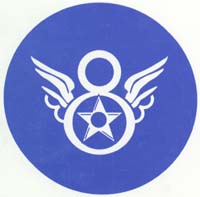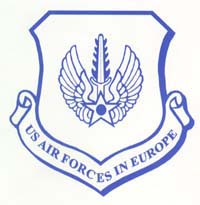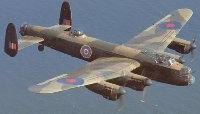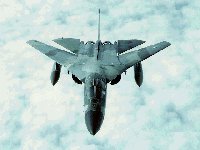 |
 |
 |
The USAAF since 1945
Introduction During World War II the Eighth Air Force alone lost 26,000 men in action, although the exact numbers cannot be known. What is sure are the memories left behind in East Anglia after an intense three years of operations by young men who are still remembered with deep respect and affection to this day. Although most of the American forces left Britain after Victory in Europe, a few bases were reactivated as the Cold War got under way. |
 |
As matters grew worse in international tension some new bases were loaned to America for use with the Thor Missile System. By the early 1960's this phase had passed, and these sites were stood down. With the fall of the Iron Curtain came further reductions in US forces held in Britain. In 1993 the twin bases at RAF Woodbridge and Bentwaters were returned to the British. In 1995 Alconbury closed after 53 years of US flying presence. Later that year Chicksands was returned to the British after 45 years in US hands. By the end of 1996 the USAFE had only 246 planes in Europe, its lowest ever level. It had peaked at 17,850 in 1945, fallen to 371 in 1950, peaked again at 2,132 in 1954, fell to 1,079 in 1964, and 700 in 1974, rose to 852 in 1989 and declined since then as the Cold War ended. The bases in the area of West Suffolk which figured in this story are listed below.
|
| RAF Mildenhall
a) Royal Air Force
Beck Row airfield, as it was first known, opened in 1934 and was immediately important as part of the Mildenhall to Melbourne Air Race won by the de Havilland Comet.
Today the Mildenhall Air Show is internationally known, but what is less well known is that important airshows have been staged at Mildenhall since before the Second World War. The Silver Jubilee Air Review was held here in July 1935 in the presence of King George V, with over 350 aircraft on show.
The first squadrons (99 and 149) at Mildenhall flew Heyford bombers and were on standby during the 1938 Munich crisis. By 1939 Wellington bombers were delivered and 99 Squadron was then re-stationed at Newmarket Heath. 149 Squadron remained at Mildenhall flying its first raid in Wellingtons in September 1939 against the German fleet near the Kiel Canal. | |

|
In November 1942 the airfield was changed from grass surface to concrete. In April 1943 operations resumed with Stirlings of XV Squadron and 622 Squadron was formed. In December 1943 both squadrons converted to Lancasters. Number 622 Squadron disbanded in August 1945 and was replaced by 44 Squadron, here until August 1946. In February 1949 four squadrons of Lancasters arrived and later converted to Lincolns. However the Lincoln was already out of date and in March 1950 these squadrons disbanded. b) United States Air Force
In mid-1950 the Americans came to Mildenhall and high security was installed. By June one squadron of B50's of 93rd Bomb Group arrived and stayed until February 1951 when 509th Bomb Group replaced them. The 2nd and 22nd Bomb Group followed in succession. Mildenhall was to become the USAF's "Gateway to Europe" as a staging post for flights from the USA. Galaxies, Starlifters and C130 Hercules all flew through Mildenhall.
In 1965 the first 5 EC135's moved to Mildenhall to take advantage of its longer runway. They started to fly one 8 hour mission a day as Operation Silk Purse. In 1966 the 513th Troop Carrier Wing had to leave France and moved to Mildenhall. By 1968 Operation Silk Purse was flying 24 hours a day. |

|
In 1982 the first of two SR71 Blackbird reconnaissance aircraft was permanently stationed at Mildenhall. These planes were at first a closely guarded secret. Reports soon circulated among locals who saw them land or take off, but were usually dismissed as they were so rarely seen. Eventually it was acknowledged that the Blackbird was a reality. |

|
In June 1987 the 513th Tactical Airlift Wing was re-designated the 513th Airborne Command and Control Wing. In 1990, with the closure of other UK bases, SAC's 11th Strategic Group and 13 KC135s moved from Fairford to Mildenhall which then held all of the in-flight refuelling KC135s in the UK. In February 1992 the 100th Air Refuelling Wing was set up at Mildenhall made up of the 513th TAW merged with SAC's 306th Strategic Wing which was deactivated. The 100th Regional Support Group was set up at the same time but in July 1994 was replaced by the expanded role of the 603rd RSG. This was deactivated in general restructuring in September 1996. In 1995 the 352nd Special Operations Group moved here from Alconbury. Still known as RAF Mildenhall, this base covers over 1,000 acres and the main runway is over 3,000 yards long. RAF Mildenhall operates its own website at www.mildenhall.af.mil. It is aimed at re-locating USAFE personnel. |
| RAF Lakenheath
and the 48th Fighter Wing
RAF Lakenheath was built in 1941 and in January 1942 Stirlings of 149 Squadron started operations here as a satellite of Mildenhall.
Lakenheath was inactive until July 1948 when the USAAF flew in B29's of 2nd Bomb Group as part of the Berlin airlift. Transports and Tankers followed and in 1951 93rd Bomb Group flew B50's from the base. Giant B36's and Globemasters followed.
High security arrived in 1952 with a high wire fence so that B47's could arrive in 1953 together with other "secret" planes including the U2.
In 1956 the B47 strategic bombers moved to the Midlands. | |

|
On 15th April 1986, 18 USAFE F111F fighter bombers flew from Lakenheath to join 15 A6 and A7 attack planes from the USS America and USS Coral Sea in the Mediterranean to bomb terrorist-related targets in Tripoli and Benghazi. One F111 and its crew of two did not return. In August 1990 18 of Lakenheath's F111s are deployed to Saudi Arabia as part of Desert Shield. 14 more go in September, 20 in November and 12 in December. Desert Storm began on 16th January 1991.
The F111's were to leave the 48th FW at Lakenheath during 1992 and the last one left in December 1992. RAF Lakenheath operates its own website at www.lakenheath.af.lak but it is of most value for American service personnel relocating to the base. |
| Shepherds' Grove
During the war, Shepherds' Grove was a base for Stirling bombers. It was, in fact, built for the USAAF in 1943, but it was assigned to the RAF's 3 Group as a satellite of Stradishall in April 1944. At the end of 1944 Shepherds Grove was transferred to 38 Group.
In 1951 it was loaned to the USAF and in August the 116th Squadron of the 81st Fighter Intercepter Wing brought in F86A Sabres, the first in this country. 92nd Squadron joined soon after. In 1952 the 116th became the 78th Fighter Squadron, and 1954 received F84F Thunderstreaks. The 78th moved to Woodbridge in December 1958.
The site then changed to agriculture with an industrial estate and extensive use for housing. | |
| Tuddenham
Tuddenham opened in October 1943 as part of 3 Group RAF and Number 90 Squadron started flying Stirlings in that month laying mines and special operations air drops.
In December 1954 the base transferred to the USAF as a sub-station of Pickenham.
|
| Go to American Connections | Updated 6 October 2004 | Go to Home Page |